I'm designing a circuit to switch a 240V AC load and haven't done a lot with AC power control before. I'm planning to use a Fairchild MC3043-M optically coupled TRIAC driver along with a BT138-600 NXP BT138-600 TRIAC. Referring to the following diagram from the datasheet:

The comment is made that for highly inductive loads (power factor < 0.5), change this value to 360R. One load I'm switching is an AC fan (0.8A) which is obviously inductive although I have no idea of the power factor likely, and the other is a router using a 20W switching supply.
My question is to make the circuit universal considering it's not for a commercial product design and I may use for other purposes in the future is there any disadvantage to always using a 360R (well guess I'll use 390R) other than needing a higher power rating for the resistor? Also any hints on calculating the power dissipation through the resistor assuming a 5A load which is what I'm planning to use as a fuse value?